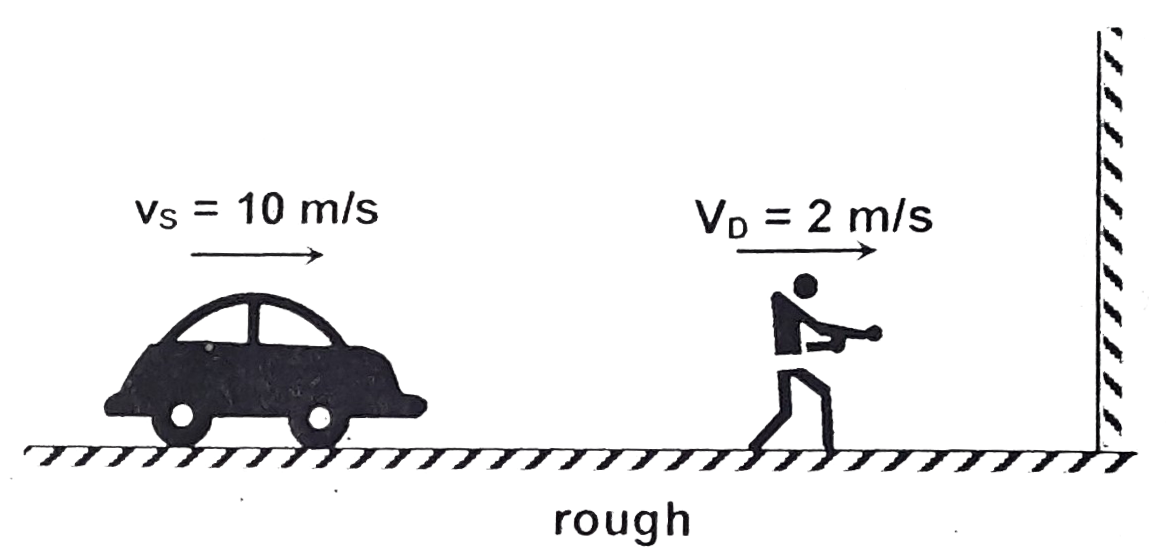Two trains A and B simultaneously start moving along parallel tracks from a station along same direction. A starts with constant acceleration 2ms2 from rest, while B with the same acceleration but with initial velocity of 40 m/s. Twenty seconds after the start, passenger of A hears whistle of B. If frequency of whistle is 1194 Hz and velocity of sound in air is 322 m/s, calculate frequency observed by the passenger.
Since both the trains move in same direction with same acceleration, therefore, their relative acceleration is zero. Initial velocity of train A is zero while that of train B is 40 m/s. Therefore, train A of observer is behind the train B or source when whistle is heard by passenger of A. Let this sound be produced at time t. Considering motion of train B (sound source) up to this instant,
u=40ms,a=2ms2,time=t
v=vb=? s=sB=? ..(i)
We have v=u+at,
vB=40+2t
s=ut+12at2
sB=40t+t2
But this sound is heard by the observer at t=20s. Considering his motion (motion of train A) up to this instant,
u=0,a=2ms2,t=20s
v=vB=?,s=sB=?
We have,
v=u+at
vA=40ms
s=ut+12at2
sA=400m
When sound was produced, train B (source) was at a distance sB from initial point while observer receives this sound at t=20s and at a distance sA from initial point. It means that sound waves travel a distance (sB−sA) in air and take time (20−t) to travel it.
sB−sA=(20−t)v ..(iii)
Where v=322ms (speed of sound). Substituting values of sA and sB in Eq.(iii),
t=18s
When sound was produced source was moving with velocity
vB=(40+2t)=76ms
(away from observer) while observer receive these sound waves at t=20s, when he was moving with velocity vA=40ms (towards the source). Hence, the observed frequency is
n=n0v+vAv+vB
Where n0=1194Hz (natural frequency of source) and so n=1086Hz.
Topper's Solved these Questions
- SOUND WAVES AND DOPPLER EFFECTBOOK - CENGAGE PHYSICS ENGLISHCHAPTER - SOUND WAVES AND DOPPLER EFFECTEXERCISE - Examples
56 Videos
- SOUND WAVES AND DOPPLER EFFECTBOOK - CENGAGE PHYSICS ENGLISHCHAPTER - SOUND WAVES AND DOPPLER EFFECTEXERCISE - Exercise 6.1
56 Videos
- RIGID BODY DYNAMICS 2BOOK - CENGAGE PHYSICS ENGLISHCHAPTER - RIGID BODY DYNAMICS 2EXERCISE - Interger
2 Videos
- SUPERPOSITION AND STANDING WAVESBOOK - CENGAGE PHYSICS ENGLISHCHAPTER - SUPERPOSITION AND STANDING WAVESEXERCISE - Comprehension Type
5 Videos
Similar Questions
A car is moving with a constant velocity 10m/s towards the stationary wall. The car blows a horn of frequency 320Hz. The velocity of sound in air is 330m/s. The beats frequency received by the observer is

View SolutionTwo cars A and B are at rest at same point initially. If A starts with uniform velocity of 40 m/sec and B starts in the same direction with constant acceleration of4m/s2,then B will catch A after :
View SolutionA body moves from rest with a uniform acceleration and travels 270 m in 3 s. Find the velocity of the body at 10 s after the start.
View SolutionA man is travelling in a train towards the station with a speed of 50 m/s. calculate the apparent frequency heard by him of whistle which is blown at the station with a frequency 200 Hz. Velocity of sound in air is 350 m/s.
View SolutionA listener is at rest and a police siren is moving away from the listerner at 60m/s. what frequency does the listerner hear given that the velocity of sound in air is 340m/s and frequency os siren is 500Hz?
View SolutionA cyclist starts from rest and moves with a constant acceleration of 1 m/s2. A boy who is 48 m behind the cyclist starts moving with a constant velocity of 10m/s. After how much time the boy meets the cyclist?
View SolutionCar A and car B start moving simultaneously in the same direction along the line joining them. Car A moves with a constant acceleration a=4m/s2, while car B moves with a constant velocity v=1m/s. At time t=0, car A is 10m behind car B. Find the time when car A overtake car B.
View SolutionAn engine blowing a whistle of frequency 133 Hz moves with a velocity of 60ms towards a hill from which an echo is heard. Calculate the frequency of the echo heard by the driver. (velocity of sound in air in 340ms.)
View SolutionAn engine blowing a whistle of frequency 133 Hz moves with a velocity of 60ms towards a wall from which an echo is heard. Calculate the frequency of the echo heard by the driver. (velocity of sound in air in 340ms.)
View SolutionA man is 45 m behind the bus when the bus starts acceleration from rest with acceleration 2.5ms2. With what minimum velocity should man start running to catch the bus?
View Solution
